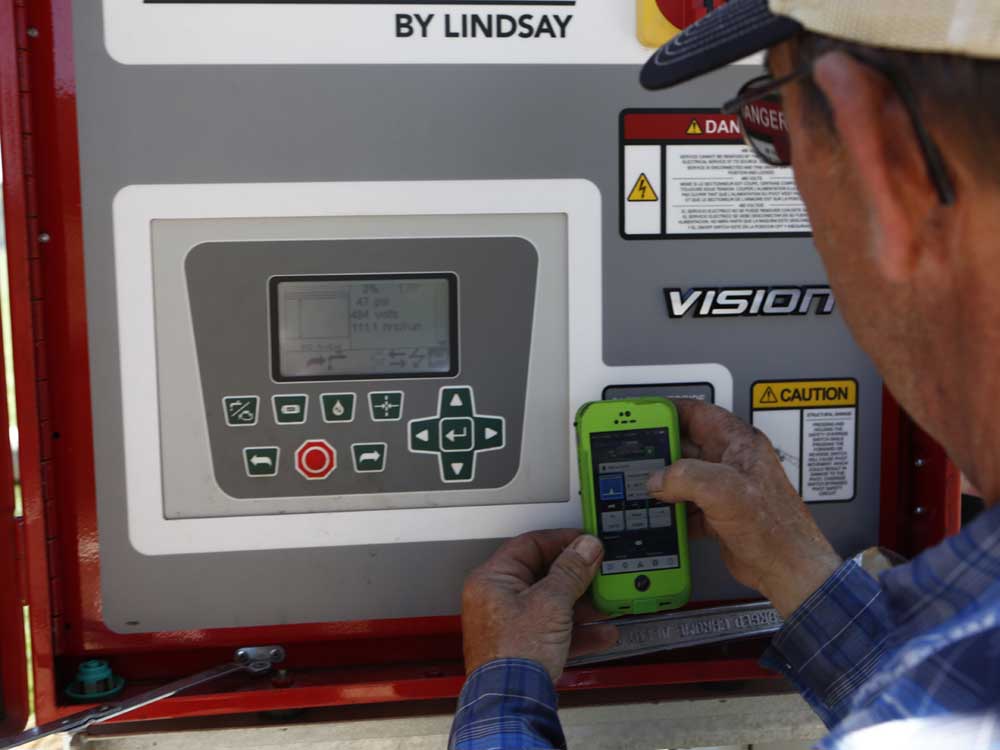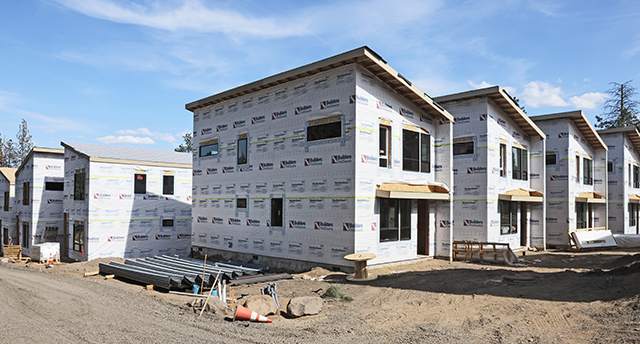Gaps in 4G network hinder high-tech agriculture
Published 12:00 am Sunday, July 31, 2016

- Jarod Opperman / The BulletinGreg Mohmen demonstrates how his phone communicates with the irrigation equipment at McGinnis Ranch near Tumalo.
Vineyard management consultant Alan Campbell set out to fine-tune irrigation across the Pacific Northwest with a system that relays soil-moisture data from the field to the computing cloud and back to the grower in real time.
His company, SmartVineyard, is trying to make it easy for wine-grape producers, plus other crop growers, to practice precision irrigation, but the system won’t work without a high-speed, or 4G, cellular connection.
As anyone who travels outside the Willamette Valley knows, there are still plenty of gaps in the high-speed network, and Campbell said that was a concern when he started the Portland-based business three years ago.
“We’re relying in the long-run on those gaps being filled in,” Campbell said.
As the Federal Communications Commission writes the rules on a second round of funding for the Mobility Fund, which subsidizes the build-out of high-speed wireless networks, politicians representing rural areas urge the agency to look beyond population measures to farm fields and grazing ranges in support of precision agriculture.
“Increasing numbers of modems in the field means a growing demand for connectivity in the areas in which they operate,” Sen. Ron Wyden, D-Ore. and 27 other senators said in a letter to the FCC.
The FCC created the Mobility Fund in 2011 with the intent of spending $500 million a year, but the level of funding and eligibility rules are up for debate in the second round. At least one commissioner, Michael O’Reilly, recently questioned the wisdom of creating separate funds for wired and wireless technology. The two technologies are rapidly converging, he argued, and so the FCC should focus on subsidizing the few remaining areas that lack broadband service of any type.
Seth Klann, who raises turf-seed grass and malting grains on 1,000 acres north of Madras, said he’s considering adding remote soil sensors, which read precise moisture levels and allow farmers to adjust irrigation, as the next stage of his precision-irrigation effort, and the high-speed cellular coverage in his area is just fine.
“Internet’s still a challenge out here,” he said, referring to land-based broadband service to the home, “more so than cell or satellite.”
The last time the FCC measured gaps in high-speed cellular coverage, the area of Central Oregon most lacking was almost all of Wheeler County, the eastern third of Jefferson County and the northeast fringe of Crook County.
Clint Shock, director of the Oregon State University Malheur Experiment Station, said he has experienced spotty cell-phone coverage all along U.S. Highway 20 east of Bend.
“You can imagine as you go away from that line, it’s really poor,” Shock said.
Wyden has heard about the 4G coverage gap from Oregon telecommunications providers, spokesman Hank Stern said in an email. Yet only one Oregon company, Eagle Telephone System Inc. in Baker County, bid on the $300 million available in the first round of Mobility Fund awards, in 2012. The Mobility Fund is one of several universal-service programs, which are supposed to ensure telecommunications infrastructure extends to remote areas and are supported by fees passed along to consumers.
Eagle was awarded $115,492 to build out 888 road-miles of wireless coverage and $7,589 to add coverage over 58 road-miles, according to the FCC. Eagle couldn’t find additional funding for the larger project and didn’t complete the 888-mile build-out, FCC spokesman Mark Wigfield said.
Wyden believes more companies will bid on the Mobility Fund if the coverage gaps are measured accurately, Stern wrote in his email. “Senator Wyden signed this letter to ensure the FCC is moving quickly to develop that much clearer picture of those rural coverage gaps, given concerns from rural Oregon communities and their residents are frustrated by slow internet connections for their work and communications needs, as well as understandable worries about gaps in cell coverage that can leave them vulnerable in an emergency,” he said.
Many precision-agriculture tools only need GPS, which is satellite-based, but those that involve continuous monitoring require high-speed wireless, said Shock, of OSU.
“The problem with precision irrigation is that you need to collect the data all the time,” Shock said. “The conditions change continually.”
Irrigation is a big focus because, while there are 8 million acres of cropland under irrigation in West Coast states, only 10 percent of farms use advanced decision-management tools, according to the U.S. Department of Agriculture.
Shock said he’s been able to test a system similar to SmartVineyard’s because the experiment station, which is four miles outside Ontario, has exceptional broadband and cellular service. Most of Eastern Oregon does not, he said.
A more basic use of precision-irrigation technology is remote operation of the watering systems. Growers can control the pressure and speed of their irrigation systems, and monitor hiccups from their offices or phones. That’s a potential time-saver for people who run dozens of irrigation systems covering many miles, but the mobile-phone features don’t work in areas without 4G, or fourth-generation, coverage, said Guy Fronk, owner of Cascade Pump & Irrigation in Bend.
“We’ve run across that in the Clarno area and Mitchell,” he said. “When we go there and do service, we don’t have cell-phone service.”
Greg Mohnen, who manages the McGinnis Ranch in Tumalo, runs center-pivot and lateral irrigation systems from a mobile phone app. The app is a convenience that allows him to monitor the systems while he’s working other farms in the area, he said, but the wireless system, provided by Zimmatic, based in Omaha, Nebraska, isn’t perfect.
“On the lateral, there’s times where I lose signal,” he said. “I’ve got to go out and unplug and replug it in.”
Drones are another technology that’s quickly becoming accessible to the average farmer, but will also rely on high-speed wireless connections, said Lucas Turpin, director of information technology for OSU’s College of Agricultural Science. While drones store data that can be retrieved post-flight, the whole effort would be more efficient if data could be streamed to the cloud mid-flight and decisions made in real-time, he said. Researchers envision a scenario in which data collected by one drone would immediately feed another drone that could precisely treat crops for disease.
“When you’re talking about spread of disease through crops, that can happen very quickly, especially when you have very windy areas and crops grown close together,” Turpin said. “Is a couple of hours going to kill a field? No, but it can have an impact on slowing the spread of disease through a crop.”
— Reporter: 541-617-7860 kmclaughlin@bendbulletin.com







